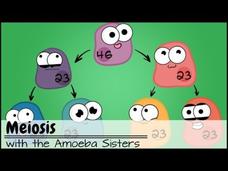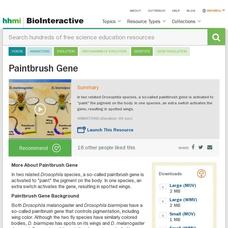Amoeba Sisters
Mutations: The Potential Power of a Small Change
Are the only mutants you know Ninja Turtles or X-Men? The video explains both gene mutation and chromosome mutation. It includes the subtypes of mutations for each major type, the times when mutations are more likely to happen, and the...
Amoeba Sisters
Viruses: Virus Replication and the Mysterious Common Cold
Viruses were nano before it was cool. The video discusses viruses such as the common cold and HIV. It includes the structure of a virus and the two cycles: the lytic cycle and the lysogenic cycle.
Howard Hughes Medical Institute
Neurons in Parietal Cortex Are Active During Straddling
How do scientists know which parts of the brain various functions use? With the help of an animated cat, viewers observe this process. They listen to the activity of one neuron as the cat steps over an obstacle and hear when the neuron...
Amoeba Sisters
Gene Expression and the Order of the Operon
Looks aren't everything. According to my biology teacher, it's what is inside you that really matters. The video explains gene expression and regulation in prokaryotes using the Order of the Operon. It includes a description of the...
Amoeba Sisters
Meiosis
Why do siblings often look so different from one another? Discover the process of making gametes using a short video from a large biology playlist. The narrator explains each step while animated chromatids play out the scenario that...
Amoeba Sisters
Alleles and Genes
How do organisms end up with such a wide variety of traits? It's in their genes! Kick off your inherited traits lesson using a brief video that covers alleles and genes. The narrator describes heterozygous and homozygous genotypes, how...
Be Smart
Could You Be Immune to Everything?
Could super immunity be the next big super power? Discover the amazing inner workings of the immune system through an engaging video from an interesting science playlist. Animated antibodies take on a variety of pathogenic invaders while...
Stated Clearly
What is Evolution?
Learn about the basics of the mechanism of evolution and the importance of natural selection, and examine evidence showing that we are seeing evolution playing out in every organism we encounter. In an engaging and easy-to-follow video,...
Howard Hughes Medical Institute
Translation (Basic Detail)
RNA translates three letters at a time to create a perfect protein chain. With the help of an animation, viewers discover the process of translation in real time. From ribosome to protein, the program creating living things finds...
Howard Hughes Medical Institute
Repellant Ephrin Signals Guide Limb Innervations
The foot bone connects to the leg bone, but how? Learn about how neurons grow in the proper direction thanks to signalling. Observe what happens when they encounter a repulsive ephrin signal and the correction process that takes place.
Howard Hughes Medical Institute
U.S. AIDS Epidemic
The first AIDS cases in the United States were reported in June of 1981. AIDS quickly became an epidemic soon and the lack of a treatment or cure caused fear in the entire population. Viewers observe a geographical representation of the...
Howard Hughes Medical Institute
Molecular Basis of Early Ltp (Short-Term Memory)
Digital amnesia: forgetting information one easily finds online. Learn how our brains move information into short-term memory at the molecular level with a short animation sure to make a memorable impression. Viewers observe a synapse...
Howard Hughes Medical Institute
Molecular Basis of Late Ltp (Long-Term Memory)
Scholars compare and contrast the molecular changes for short-term and long term-memory with the help of animated videos. Viewers see the chemical process that changes the brain and stores memories thanks to dopamine.
Curated OER
Phases of Mitosis
The lecturer starts by emphasizing that the mitotic process is a separate mechanism to cytokinesis - the cytoplasm splitting to become 2 cells. The video continues explaining the stages of mitosis in great detail. Each stage is...
Curated OER
Embryonic Stem Cells
A presentation which concentrates on the development of the blastocyst and embryo after fertilization. Topics start with the scientific names and processes at each stage and then develops into an explanation of embryonic and somatic stem...
Crash Course
Animal Behavior
While a herd of cows are eating, they tend to all face the same direction. Viewers explore the world of animal behavior, looking at both morphology and physiology, with a video that focuses on the evolutionary history of learned...
Crash Course
Photosynthesis
Seventy percent of the world's oxygen is produced through photosynthesis by phytoplankton, microscopic plants found in the ocean. Viewers learn about the complex process of photosynthesis with a video that covers both the light dependent...
Crash Course
Circulatory and Respiratory Systems
Viewers follow the paths of oxygen and carbon dioxide through the human respiratory organs and the path of the molecules through the human circulatory system, in a short video about how the body delivers oxygen and picks up carbon dioxide.
Be Smart
Why Do You Love Your Family?
Is that warm, fuzzy family feeling a product of evolution? Explore altruism through a video from an engaging science series. The narrator discusses parental instincts, evolutionary fitness, and an organism's drive to ensure it passes its...
Howard Hughes Medical Institute
Paintbrush Gene
Drosophila includes more than 1,500 species and often find themselves studied by geneticists. A scientist presents a lecture on one example of these studies on the paintbrush gene. The gene determines the amount and color of pigment on...





















